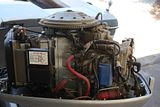Yes.... Purchase a carburetor kit either on this site, your dealership, NAPA, any marine type store, etc. Remove, clean, and rebuild the carburetor. Make sure the kit includes the float OR purchase a float separately.
(Carburetor Adjustment - Single S/S Adjustable Needle Valve)
(J. Reeves)
Initial setting is: Slow speed = seat gently, then open 1-1/2 turns.
Start engine and set the rpms to where it just stays running. In segments of 1/8 turns, start to turn the S/S needle valve in. Wait a few seconds for the engine to respond. As you turn the valve in, the rpms will increase. Lower the rpms again to where the engine will just stay running.
Eventually you'll hit the point where the engine wants to die out or it will spit back (sounds like a mild backfire). At that point, back out the valve 1/4 turn. Within that 1/4 turn, you'll find the smoothest slow speed setting.
Note 1: As a final double check setting of the slow speed valve(s), if the engine has more than one carburetor, do not attempt to gradually adjust all of the valves/carburetors at the same time. Do one at a time until you hit the above response (die out or spit back), then go on to the next valve/carburetor. It may be necessary to back out "all" of the slow speed adjustable needle valves 1/8 turn before doing this final adjustment due to the fact that one of the valves might be initially set ever so slightly lean.
Note 2: If the engine should be a three (3) cylinder engine with three (3) carburetors, start the adjustment sequence with the center carburetor.
When you have finished the above adjustment, you will have no reason to move them again unless the carburetor fouls/gums up from sitting, in which case you would be required to remove, clean, and rebuild the carburetor anyway.
(Carburetor Float Setting)
(J. Reeves)
With the carburetor body held upside down, the float being viewed from the side, adjust the float so that the free end of the float (the end opposite the hinge pin) is ever so slightly higher (just ever so slightly off level) than the other end. And when viewed from the end, make sure it is not cocked.

 Can this part be interchanged with a different year?
Can this part be interchanged with a different year? 


